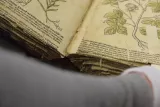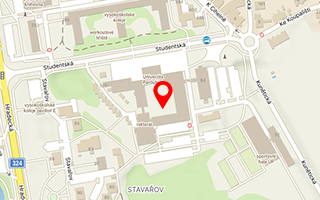Published: 24.09.2020
Some are five hundred years old. They are old and damaged. Yet beautiful. Their new life starts at the Faculty of Restoration. We are talking about books. Ivan Kopáčik, Head of the Studio of Restoration and Conservation of Paper, Bookbinding and Documents takes one such book and describes in detail how students save historical gems with fascinating history.
He presents the first book. He is using white gloves to hold a restored late-Gothic book from the turn of the 15th century and to put it on soft foam. At the same time he is taking out a wedge to lean the book against it. This is to prevent damage to the book spine. He adds that gloves are not generally used unless, for example, solvents are used. The restorers would not feel the books that well if they used gloves.
“Hunting motives are typical of this period, you can see them in blind blocking patterns on the spine; the label and the clips do not show much of Gothics motives,“ says Ivo Kopáčik about the characteristics of gothics, which is a style born in France. Engraving on the title page of the book dates back to 1522 and is a case of wood block. It is amazing. For example, the Pernštejn family used to read such books.
I wonder what a restorer can do to stay within permitted limits. I am told that book restorers are bound by codes of ethics. “We are completing missing parts, such as parts of sheets, but we avoid retouching; only rarely do we add lines to complete a drawing. We do not want to interfere with the image because we could draw something that was actually never on the paper,“ says Kopáčik. When looking at the book, you notice that some completed parts of the sheets have not been completed with a pen. No writing or drawing has been added. The sheets bear numbers only on their face. So the number of pages is double the number of sheets.
Charm of Mattioli's Herbarium
The next thing Ivan Kopáčik shows to me is Mattioli’s Herbarium from the 16th century, which is all tattered. Individual sheets are inserted in the book and the binding is loose. “When we take the decision to take the book apart, we dismantle it into individual sheets. We need to remove the threads and dismantle the entire threading. We do not throw anything away; what cannot be removed will be kept as fragments in a special plastic film as part of the book,“says Kopáčik. Each student has one book assigned and works on it throughout the year and individually takes all steps to save the book. Collective guilt is not an available defense.
Before the restoration begins, analyses are performed to discover the extent of damage. For example, microbiological analyses reveal whether the book has been infected with bacteria or viruses, since such germs may pose a threat to the restorer. Then, the bookbinding and the block are cleaned, and the individual sheets are dismantled. The cover and hardware receive special treatment. I am surprised at how skillful students are when they can prepare the clips themselves in the studio. “We use no prefabricated pieces, students get a brass sheet to work with. The only ready-made thing used is wood plates used to manufacture the book. Until the Industrial Revolution, each book was an unique piece, and each component part was an original. We do it the same way,“ says Ivan Kopáčik.
There is one more herbarium, this time a Renaissance one, from the Jevíčko Town Museum, which contains a small plastic bag whose content I cannot identify. A student has already been assigned the book and has kept fragments of the book. Parts of the parchment and threads could come useful in the future if the restorers want to discover the composition of the fiber, and analyse it. In fact, there is one real plant in the herbarium. You will actually be able to find what ailments it is used for since the herbarium is written in Old Czech language in Gothic script.
Herbaria passed from generation to generation since they were extremely valuable. “Their owners kept repairing them, adding new parts, and the books were heavily annotated. Sometimes, we are critical of their amateur interferences which make the life difficult for us, but had it not been for them, there may be nothing left.“
Books of known and unknown origin
As he is speaking, Ivan Kopáčik, head of the studio, leafs through a book using a bone folder, which separates the sheets one from another. It is hard to imagine for me how much fiddly work is involved before all is put together and the restored book is returned to the owner. Therefore, I ask who is, and was, the owner of the books. “We restore books for public institutions. For example, Olomouc Research Library, Náchod Region Museum or Strakonice Museum. A big job is a study of 16 000 books from Benedictine library in the Broumov monastery. We save the books which are damaged to the largest extent. We also go over all the books and try to learn as much as possible about the book from typological signs. By doing so, we map the development of bookbinding,“ says Mr. Kopáčik and adds that books can reveal a great number of useful historical facts. Any questions that come to the restorers’ minds are discussed with the colleagues of the Faculty’s Department of Humanities. The issues related to the composition are discussed with colleagues from the Faculty’s Department of Chemical Technology.
In a restorer’s workshop
To show me how the restorer’s work looks like, Ivan Kopáčik takes me directly to their workshops. They look like labs, or at least the room where sheets from the books are immersed in some solutions and the shelves are full of solvents and colourings does. Two BA students in their fourth year are doing their internship there. BA study at the Faculty takes four years.
One of the students is standing by the table used for refilling paper pulp. Her job is to immerse the individual sheets in water. “The sheets are immersed for some 15 minutes, during which they release some impurities that we were unable to remove by mechanical cleaning. I am able to clean even 40 pages in a day,“ says Marie Vaňková to describe her work. Tereza Kubalová is standing next to her and is performing further restoration work on a book of travels from the 17th century. “My task is to add any missing parts using paper suspension with a glue. Then excessive water is siphoned off. Once the sheet has the required number of layers, it is dried.“ It remains in the drier for approximately a day and then the sheets are bound again.
Magical feats without magic
I am also observing first-year students who are learning how to do bookbinding. They are unlike Ludmila Stašová, a third-year student, who has already restored one 16th century book. “I have already repaired the block; what I need to do is aligning any overlays, which I used to complete any losses of the original paper underlay. I will also need to putty the board so that it does not contain any holes produced by the wood beetle. The board has ruptures ,“ says Ludmila, who has been working on the book for more than a year. What inspired her to choose this field?“Restoration is a nice craft that intertwines history and artwork. I have always wanted to do something practical. In addition, I learn a lot about the history of art as well as chemistry. My ambition is to work in a library or gallery.“ Martin Tůma, a second-year student, has also fallen for book restoration. He has just alligned the underlay and starts to add the missing sheets.“Of course, I like reading books. But what I like even more is bringing them back to life. That is why I chose this field. I like the work, which is related to history and arts.“
Even though restorers are not magicians, they can do miracles, even though they need their time. They can restore a book damaged by fire. They have had such a case where it was originally impossible to open a book, which is fully usable these days. “We cannot restore the book once and for all, we can improve its condition, we will certainly not cause any damage. The rest depends on each institution how it will store the book to make it survive longer,“ says Ivan Kopáčik by way of conclusion.
Studio of Restoration and Conservation of Paper, Bookbinding and Documents
Students are admitted to study on the basis of aptitude testing. Applicants should have knowledge of chemistry, history of arts, fundamentals in history and be able to draw a still life and a portrait. The focus of the BA study lies in bookbinding, in particularly old books dating to 15-18th centuries. The first year of study introduces students to the practicalities of the bookbinding workshop and the operation of the studio, and students learn about the book and materials. In the following years, student learn to work with individual books. The BA study lasts four years and is followed up by MA study. Students focus on marginal and specific parts of book culture, e.g. parchments. Students also work with modern-day polygraphic materials from the end of the 18the century onwards.


